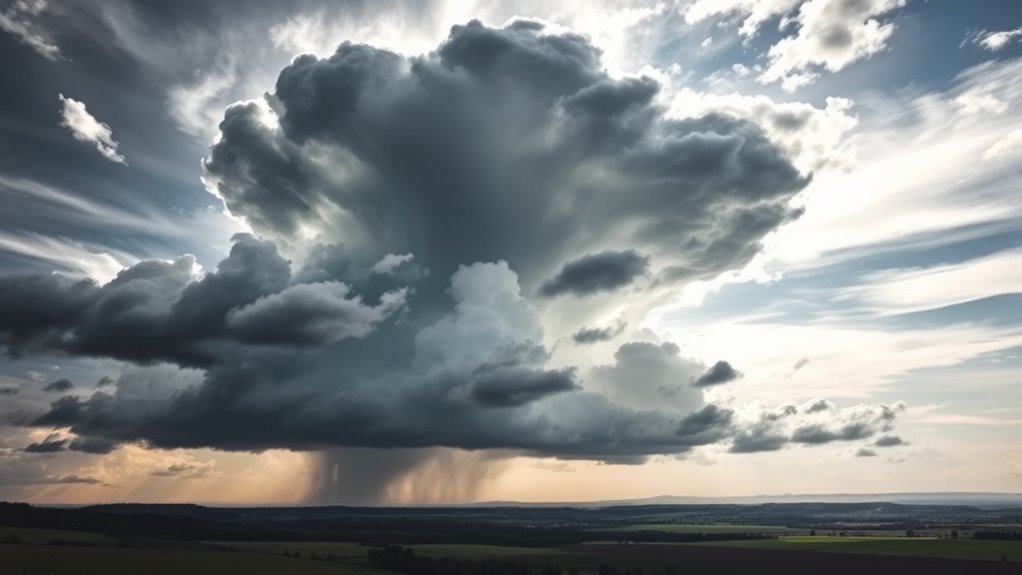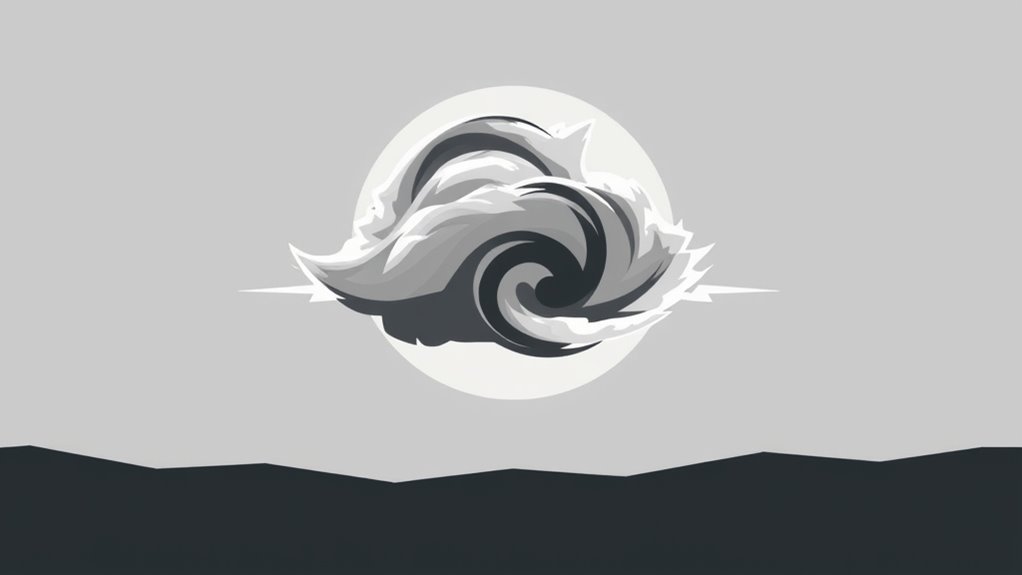Many people mistake squalls for other storm types due to their rapid onset and intense wind changes. These short-lived events can resemble thunderstorms because of sudden downpours and strong gusts. Nevertheless, squalls differ in duration and atmospheric conditions. Their brief but violent nature often leads to confusion with hurricanes and tornadoes, both of which are more organized and longer-lasting. Understanding these differences can improve awareness and preparedness, revealing more about storm behavior.
Main Points
- Sudden and sharp increases in wind speed can easily confuse observers, making squalls resemble severe thunderstorms or other storm types.
- The brief duration of squalls may lead people to underestimate their intensity, mistaking them for less severe weather events.
- Visual similarities, such as darkening skies and cloud formations, contribute to misidentification between squalls and thunderstorms or hurricanes.
- Lack of thunder or lightning during squalls can mislead individuals who expect these features from typical storm systems.
- Misunderstanding the characteristics of squalls can lead to inadequate preparation, heightening risks during adverse weather conditions.
Understanding Squalls: Definition and Characteristics
Squalls are sudden, sharp increases in wind speed associated with a disturbance in the atmosphere. They can occur rapidly, often without notable warning, and typically last for a short duration.
Characteristically, squalls are marked by a remarkable increase in wind intensity, sometimes exceeding 20 knots within a matter of minutes. They are frequently accompanied by severe weather phenomena, such as heavy rain, hail, or thunderstorms, which can further complicate their identification.
Squalls can arise from various weather conditions, including cold fronts or localized thunderstorms. Their unpredictable nature can lead to confusion with other storm types, especially for individuals untrained in meteorological patterns.
The abruptness of squalls can pose dangers to both maritime and aviation activities, highlighting the importance of recognizing their distinct characteristics. Understanding these defining features is essential for accurate weather assessment and safety measures.
The Nature of Wind and Precipitation in Squalls

While squalls are often defined by their rapid onset, the interplay of wind and precipitation during these events is vital to understanding their impact.
Squalls typically feature sudden increases in wind speed, which can reach gale-force levels in a matter of moments. This intense wind is often accompanied by heavy rain, snow, or even hail, creating a chaotic environment that can be easily mistaken for other storm types.
The wind direction may shift dramatically as the squall approaches, further complicating the situation for those caught in its path. The precipitation associated with squalls tends to be brief but intense, leading to reduced visibility and hazardous conditions.
This combination of sudden wind changes and heavy precipitation creates a volatile scenario, which can mislead observers into misclassifying the event. Understanding these dynamics is vital for accurate storm identification and for ensuring safety during squall occurrences.
Comparing Squalls to Thunderstorms
When comparing squalls to thunderstorms, it is essential to identify their key characteristics.
Squalls often present rapid changes in wind and precipitation, while thunderstorms are typically associated with more prolonged rainfall and lightning.
Visual and sensory cues, such as cloud formations and sound patterns, can further aid in distinguishing between these two storm types.
Key Characteristics Differentiated
Though both squalls and thunderstorms can produce intense weather conditions, they are distinct phenomena with unique traits.
Squalls are typically sudden, brief bursts of strong wind and heavy precipitation, often associated with cold fronts. They can occur without considerable thunder or lightning, making them less dramatic in appearance.
In contrast, thunderstorms are defined by their formation of cumulonimbus clouds, which can generate lightning, thunder, and even hail. Thunderstorms usually last longer and can develop into severe weather systems, including tornadoes.
Additionally, squalls are often localized events, while thunderstorms can cover a wider area. Understanding these differences is essential for accurately identifying and responding to each type of storm.
Visual and Sensory Cues
Recognizing the visual and sensory cues of squalls and thunderstorms can greatly aid in their identification.
Squalls typically manifest as a sudden, sharp increase in wind speed, often accompanied by darkening skies. The clouds may appear as a thick, uniform layer, often leading to brief but intense rainfall.
In contrast, thunderstorms present more dynamic visual cues, including towering cumulonimbus clouds that develop vertically, indicating rising air. Thunderstorms also produce distinct auditory signals, such as thunder and the crackling of lightning, which are less common in squalls.
While squalls may exhibit brief gusts, their general duration is shorter compared to thunderstorms, which can persist for hours.
Understanding these differences allows individuals to better prepare for varying storm conditions.
Distinguishing Squalls From Hurricanes

How can one effectively differentiate between squalls and hurricanes, given their often similar appearances? Distinguishing these two storm types requires an understanding of their characteristics.
Squalls are typically short-lived, localized bursts of strong winds and heavy rain, often lasting less than an hour. In contrast, hurricanes are large, organized systems with sustained winds exceeding 74 mph and can last days or even weeks, affecting extensive areas.
Additionally, the formation of squalls tends to occur along cold fronts, whereas hurricanes form over warm ocean waters. The cloud structure also differs; squalls usually present as towering cumulonimbus clouds, while hurricanes display a more organized spiral structure with a clearly defined eye at the center.
Finally, the intensity and scale of wind and rain provide critical clues. Squalls deliver intense bursts of weather but not the sustained ferocity associated with hurricanes, helping observers distinguish between the two storm types effectively.
The Differences Between Squalls and Tornadoes

Understanding the differences between squalls and tornadoes is essential for accurate weather forecasting.
Wind speed variations, formation characteristics, and the duration and impact of these phenomena highlight their distinct nature.
Wind Speed Variations
While both squalls and tornadoes can produce intense wind speeds, their characteristics and formation processes are distinctly different.
Squalls typically involve rapid increases in wind speed associated with a cold front, often resulting in gusts reaching 35 to 50 knots. These events are generally short-lived and occur over a larger area.
In contrast, tornadoes can generate extreme wind speeds, sometimes exceeding 300 miles per hour, but are localized phenomena. The concentrated nature of tornadoes contributes to their destructive potential, while squalls, although powerful, usually cause less widespread damage.
Understanding these wind speed variations is essential for accurate storm identification, as mistaking squalls for tornadoes can lead to inappropriate responses and heightened anxiety during severe weather events.
Formation Characteristics
Although both squalls and tornadoes are types of severe weather, their formation traits reveal notable differences that are essential for accurate identification.
Squalls typically develop along cold fronts, resulting from the lifting of warm, moist air over a denser cold air mass. In contrast, tornadoes form from supercell thunderstorms, defined by a rotating updraft known as a mesocyclone.
Key differences include:
- Origins: Squalls arise from frontal systems, while tornadoes originate from severe thunderstorms.
- Structure: Squalls are often broad, linear phenomena, whereas tornadoes are narrow and funnel-shaped.
- Atmospheric Conditions: Squall formation is linked to temperature contrasts, while tornadoes require specific wind shear and instability in the atmosphere.
Understanding these differences aids in recognizing and responding to severe weather events.
Duration and Impact
The duration and impact of squalls and tornadoes differ considerably, influencing their potential threat levels.
Squalls are typically short-lived, often lasting from a few minutes to several hours, distinguished by sudden increases in wind and precipitation. Their impact is usually localized, leading to temporary disruptions in weather conditions, but they rarely cause severe damage.
In contrast, tornadoes can last from a few seconds to over an hour, with the potential for widespread destruction along their path. The winds associated with tornadoes can reach devastating speeds, resulting in notable property damage and loss of life.
Understanding these differences helps individuals identify the severity of each storm type, aiding in appropriate preparation and response strategies.
Common Misconceptions About Squalls
What distinguishes squalls from other storm types often remains unclear, leading to several misconceptions. Many individuals conflate squalls with severe thunderstorms, failing to acknowledge that squalls can occur without thunder or lightning. This misunderstanding can result in underestimating the potential hazards associated with squalls.
Another common misconception is that squalls are always accompanied by heavy rain. In reality, squalls can feature strong winds and minimal precipitation, creating dangerous conditions without the expected downpour.
Finally, some people believe that squalls are long-lasting events; nonetheless, they typically come and go relatively quickly, often lasting only a few minutes to an hour.
To clarify, here are three key misconceptions about squalls:
- Squalls are always severe thunderstorms.
- Squalls must produce heavy rain to be classified as such.
- Squalls last for extended periods.
The Importance of Accurate Weather Interpretation
Accurate weather interpretation is essential for understanding the nuances of various storm types, including squalls. Misidentifying these phenomena can lead to inadequate preparation and heightened risk during adverse weather conditions. Squalls, defined by sudden and intense winds and precipitation, differ markedly from other storms such as thunderstorms or hurricanes. Recognizing these differences is vital for both meteorologists and the general public.
Furthermore, confusion between storm types can result in miscommunication about safety protocols and emergency responses. For instance, underestimating a squall's intensity may leave individuals unprepared, leading to potentially dangerous situations.
Effective weather interpretation enables better decision-making, nurturing a culture of awareness and preparedness. As climate patterns evolve, the ability to accurately interpret weather data becomes increasingly necessary.
Common Questions
Can Squalls Occur Without Precipitation?
Squalls can occur without precipitation, marked by sudden increases in wind speed. These wind events may arise from atmospheric disturbances, leading to turbulent conditions even in the absence of rain or other forms of moisture.
How Do Squalls Form in Different Climates?
Squalls form through various mechanisms across climates, such as temperature contrasts, frontal boundaries, and localized convection. These factors can create intense winds and rapidly changing weather conditions, regardless of the general climate type present in the area.
Are Squalls Dangerous for Small Boats?
Squalls can pose considerable dangers for small boats due to sudden, intense winds and rapidly changing conditions. Their unpredictable nature often catches sailors off guard, leading to potential capsizing or loss of control at sea.
What Technology Helps Predict Squalls?
Advanced radar systems and satellite imagery play essential roles in predicting squalls. Meteorologists utilize weather models to analyze atmospheric conditions, enabling timely warnings and enhancing safety for mariners and aviation personnel in affected regions.
How Long Do Squalls Typically Last?
Squalls typically last from a few minutes to about an hour. Their duration can vary based on atmospheric conditions and geographical location, often leading to sudden and intense weather changes in a short time frame.

